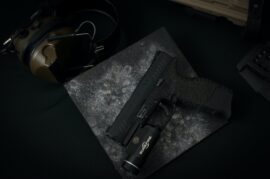
How to Hydro-dip Your Firearms
Cerakoting, bluing, chrome-plating, and others are all great finishes, but they always don’t work with wood or plastic stocks. They also take considerable time to apply, and not a little bit of care with heat and/or chemical mixes. Hydro-dipping is a fairly recent refinishing method that permits quick and relatively simple application of patterns and images onto gun stocks or pistol frames and slides. Major advantages of hydro-dipping are the low temperatures involved and the low toxicity of the process.
The Hydro-dipping Process
The process is fairly simple in principle: a pre-printed polymer skin gets wetted down in an 80-85*F batch and stretched over a clean, dry stock or a frame of a gun. The picture or pattern wraps around to cover the entire surface, then the excess skin is trimmed. The seam is usually located at the top of a stock or a frame, where it’s not readily visible. The trick is to do the wrapping cleanly and with proper alignment in one try — that takes a bit of practice.
The film must be placed flat in the water to avoid bubbles. The film is then touched carefully to iron out any folds. Activating spray makes it ready to adhere. The film has to be applied to surfaces, often complex, without it kinking onto itself. To achieve that, the entire part is dipped through the film that’s floating on the surface of the water. The part of the film that does not adhere to the part being dipped just stays floating, separating from the activated portion of the pattern sheet. Since the patterns are often semi-translucent, polymer color or paint applied over metal shows through as the base tone.
To finalize the process, the part is rinsed and air dried. Since the process is unique to each object, the placement of details differs from gun to gun.
The process proved extremely popular, with anything from camouflage patterns to $100 bills to fake wood grain being used. While hydro-dipping is usually applied to plastic, it can be used on metal, glass, and wood as well. It’s often used on vehicles. I had a British P1914 with old, surface-damaged stock — Spectrum Coatings in Florida wrapped a nice wood-grain skin over the un-pretty wood with such realism that I didn’t even think it was a surface coating at first. The downside to hydro-dipping is the relatively low resistance of the finish to abrasion compared to Cerakote. Clear coat sealant overspray can make the pattern more resistant to abrasion and chemicals.
By: Oleg Volk, Firearms Photographer

